OK..... this is gonna' offend a lot of people so, to those of you who're all about maintaining the mystique DON'T READ!!!
I am not a gunsmith, I'm a hobbyist. And gunsmith's, especially winning BR Gunsmith's generally do things their way.
I'm a construction guy. I got a lathe because I couldn't pay people enough to get them to build stuff how I wanted.
But I
BUILD stuff, "FFF" is my mantra, Form Follows Function. I was mentioning a catshead over on another post and for some reason searched 'cathead' and 'catshead' on google (I guess to find out if it had the 's' or not) and saw lots of pixtures of wikkid shiney machined stainless steel catheads.... and I kinda giggled. Mine ain't stainless steel......I needed one so I picked out a hunka' thickwall pipe and whipped one up.
It ain't purdy!! But it cost me 7 bucks.
View attachment 14487
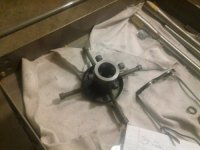
Same with my barrel extensions...... THEY AIN'T PRETTY.... but they work for me. They WORK for me because
I do not chamber between centers.... I won't even argue the fact that just maybe using the two points of muzzle and throat is better than the "Gordy Method" but in any case I LOCATE THE THROAT no matter how large and long the case and I DO USE GORDY GRITTERS' METHOD of straightening and using only the three inch or so section fore and aft of the throat and letting the rest of the barrel whip around wildly......I believe Gordy came up with a system that
solves 8 of the 10 lingering problems and I've solved the other two to my satisfaction.
ONE of the fixes is barrel extensions. Barrel extensions are the direct result of me despising, not trusting
anything "machined between centers" unless I personally established a repeatable, straight centerline. IMpossible with barrels...Barrels are bent. At least the GOOD ones are...... "bent barrels are best" has been my belief. Soooo, Barrel Extensions.... in my case made of cheap or in some cases found materials.... Sure, I could go out and buy ss barstock and make stuff that looks good enough to wear but that ain't my WAY.
So.....here's my first one. I needed to add length and hadda' hunka' pipe...well, tubing actually, pipe is the wrong size.
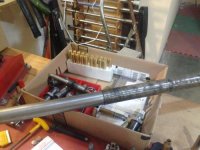
It's threaded for a Sav110, but it only works for muzzle devices, it attaches to the chambered end. This pertickler project I chambered prior to bandsawing the barrel down.....and this sort of extension, while useful after the fact is bulky and limited in usage.
And for chambering I needed something much more versatile. So I started looking at PIPE, black iron PIPE and the myriad of fittages and encumbrances thereof. PIPE, whether it be galvanized or black is weird stuff to machine but it does take t'reads and it won't ever gall. (All y'all reading this that don't think THAT'S a problem have never worked with barrel and action stainless steels. They SSUUCKK!!!!, some worse than others but there are actions being made that IF YOU BOLT THEM INTO A STOCK WITHOUT GREASE you may not get back apart. Schucks, I once bottomed out a screw into an expensive action WITH MY FINGERS, I was testing the depth of a hole, and had to machine it out. And barreled actions??? DEADLY!
Sooooo, pipe is GOOD

Anyways, for those of you that believe The GordyMonster is onto something with his methods, and who shoot stuff other than PPC, here are some pix.
But for those of you who think Gordy Gritters is crazy....
And ESPECIALLY for those who think I'm crazy wit' de' 'stensions....DON'T LOOK!!!
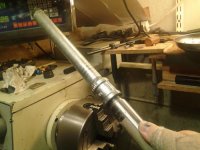
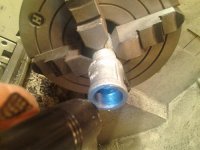
And you k'in go hog wild here....... with PIPE FITTINGS you have the sizes you need, and you can adapt up and down. F'rinstance the black iron 3/4 to 1/2 reducing coupler (reducer) can be machined to accept a 700tenon on one end and a #5 muzzle brake thread on the other....... get it???
And then there's merchant couplers and brass fittings..... and unions, let's not ferget unions....the universal joint of the pipefitting world....
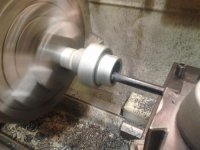
They thread fine, you may have to machine them down to fith thru the headstock....
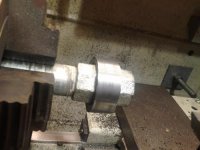
So, these are the pix I took. Not all the fittings by any means but you hopefully can get the idea.
There's nothing cheesy about this methodology..... if others want to machine nicely fitted shiney pieces so be it but it's the IDEA that counts. The METHODOLOGY..... When I say "I make a 338 Lapua to as accurate a spec as a BR Grade 6PPC"....... I MEAN IT! And to all you'se whiners that have never gone in and LOOKED AT the runout, the crookedyness present in gun barrels, just keep on believing that barrels are straight. And if others are happy jamming stuff up into the tailstock spindle bore and calling it straight...... I've got blanks here where if you chopped off hunks and made wheels your jalopy would ride like the FlintStoneMobile.....Holes in the middle??? Don't make me laff.
Ignorance Is Bliss
al
trying to get these stupid pictures to work...








